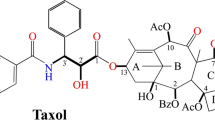Abstract.
Over the past decade, Taxol and its closely related structural analogue Taxotere have emerged as very important antitumor agents. Their widespread use in the treatment of a variety of cancer types, their likely approval for the treatment of additional forms of cancer, and their use at earlier stages of intervention will lead to increased demand for these drugs in the future. Because of yield considerations, Taxol and Taxotere are currently derived via semisynthesis from the advanced taxoid 10-deacetylbaccatin III, which must be isolated from yew (Taxus) trees. Thus, efforts are underway to produce Taxol (and other advanced taxoids for use in semisynthesis) by alternate, biotechnological means. This article provides a current overview of research on taxoid biosynthesis and an assessment of bioengineering applications for taxoid production in yew cell culture.
Similar content being viewed by others
Author information
Authors and Affiliations
Additional information
Received revision: 11 June 2001
Electronic Publication
Rights and permissions
About this article
Cite this article
Jennewein, .S., Croteau, .R. Taxol: biosynthesis, molecular genetics, and biotechnological applications. Appl Microbiol Biotechnol 57, 13–19 (2001). https://doi.org/10.1007/s002530100757
Received:
Accepted:
Issue Date:
DOI: https://doi.org/10.1007/s002530100757




